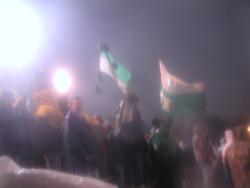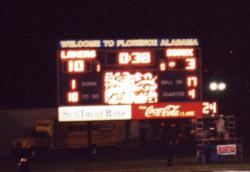Owning a college sports web site doesn’t usually bring with it much intrigue or drama, though having a blog does allow me to share interesting stories about the online college hockey world with you when they do occur.
Does USCHO exclusively own the term “PAIRWISE”, as it relates to college hockey rankings? For now the answer appears to be no, though USCHO has been trying to change that. I first became aware of this effort when USCHO added a small “SM” to their “Pairwise” tables on their site last spring. I dashed off to the United States Patent and Trademark Office to investigate, which you may also want to do so you can follow along:
USCHO’s claim to Pairwise
Mar. 20, 2006
USCHO’s initial application for trademark for “PAIRWISE”
Apr. 17, 2006
The next action in the file, described as “Paper Correspondence Incoming”, came from a bunch of names you might recognize as formerly associated with USCHO: Mike Machnik (founder of HOCKEY-L, now affiliated with CollegeHockeyNews), Adam Wodon (founder of CollegeHockeyNews), John Whelan (developer of some pretty neat hockey ranking analysis tools, wrote USCHO’s Pairwise analysis tools, now with CollegeHockeyNews) and Keith Instone (long-time HOCKEY-L ranking guru, first devised the pairwise technique to mimic the selection process). Their letter raised quite a few objections to USCHO’s application, including the following:
- Pairwise is a generic mathematical term that describes how the comparison is performed
- The algorithm, in relation to college hockey, was developed by Keith Instone before USCHO existed
- USCHO doesn’t use the term “pairwise” in commerce, as they claimed
- The sample of “advertising” submitted by USCHO was not, indeed, advertising, but a page of hockey rankings
- Lots of other sites cover college hockey and publish pairwise rankings of teams
Compelling stuff, particularly the first, which is why I was surprised to see the next document…
Sep. 11, 2006 Office Action Outgoing
No mention of the Apr. 17 “Paper Correspondence Incoming”. Notes were pretty much limited to the following:
Office records have been search and no similar registered and pending mark has been found that would bar registration
The wording used to describe the services needs clarification because it is unacceptable as indefinite. Applicant may adopt the following identification of services, if accurate: Providing information in the field of rankings of college hockey teams; and publication of books featuring rankings of college hockey teams.
Though there seemed to be some confusion between the two parties about wording (is USCHO a book or a web site? is PAIRWISE a marketing slogan or the name of a database?), it seemed like USCHO just needed to adopt the suggested description. I start getting ready to scrub the word “pairwise” from SiouxSports.com and come up with the SiouxSports.com Power (PWR) rankings (which is what everyone thinks PWR stands for, anyway).
Nov. 22, 2006 Response to Office Action
USCHO seems pleased with the change in wording, though did want to note that they publish a website, not books.
Jan. 25, 2007 Office Action Outgoing
Pointing out that USCHO is a web site, not a book, seemed to have compelled the USPTO to search the web, because it came back now denying the claim:
Registration is refused because the proposed mark merely describes a characteristic and feature of applicant’s goods and services
The proposed mark appears to be generic in connection with the identified services
According to the Internet evidence, a ‘pairwise comparison’ is a problem solving method that allows one to determine the relative order (ranking) of a group of items
The mark… is a commonly used term for ranking college hockey teams
Evidence for the denial included a mountain of captured web pages (what did trademark examiners do 10 years ago?)
Page 1 — The first few pages are from Wikipedia. Really? It was my understanding that students aren’t allowed to cite wikipedia in fifth grade reports, yet the PTO uses it? Ok, let’s see what else they have…
Page 9 — Wiktionary?!? Seriously, will someone buy the PTO a subscription to the OED? I think m-w.com is free.
Page 10 — Mathworld, that sounds like an amusement park where I could imagine running into Whelan.
Page 12-16 — SiouxSports.com. w00t. I’m particularly impressed that he grabbed our awesome individual team detailed pairwise comparisons table, which I still think is the best on the net.
Jul. 25, 2007 Response to Office Action
Obviously, PAIRWISE is not descriptive of a ranking
Eh?
Even if the word “Pairwise” has become descriptive of a general process by which items are ordered and ranked by comparing each item to another, the fact that such a process is employed in a specific sport application in which the source of the ranking chooses and assigns weights to selected criteria makes it clear that the word is, at best, suggestive of what makes PAIRWISE rankings better than its competition.
Ok, I think I’m getting it. USCHO is trying to lay claim to PAIRWISE in all caps, differentiated from pairwise, the descriptive term. Huh.
From Tim Brule’s letter:
The success of our PAIRWISE rankings help establish uscho.com as a definitive source of information about college hockey and consequently increases the traffic to our site. Obviously it is economically benefical to us to have high traffic rankings.
Ah, is this about search results? Let’s google “pairwise hockey“:
USCHO.com::U.S. College Hockey Online::Pairwise
USCHO.com::U.S. College Hockey Online::Pairwise Surprise
College Hockey News: NCAA Tournament Pairwise Comparison Ratings
College Hockey News: Pairwise and KRACH
SiouxSports.com: NCAA College Hockey PWR (Pairwise Rankings)
Is USCHO’s new desire to trademark PAIRWISE because CollegeHockeyNews is gaining ground as a source of that information? It hardly seems a coincidence that this occurred so soon after the CHN guys split off.
Sep. 5, 2007 Office Action Outgoing
The examining attorney has also considered the applicant’s arguments carefully but has found them unpersuasive.
The applicant has responded to the refusal by stating that the proposed mark is not descriptive of the applicant’s services. The examining attorney disagrees
The term “PAIRWISE” as used in the mark merely indicates that the pairwise method was used to generate the college hockey team rankings.
Let’s take a look at PTO’s new evidence (much of it from the same source as the previous):
Page 4-6: Is PTO really using a page from USCHO’s site to try to demonstrate that Pairwise is a generic description. I don’t get this one.
Page 7-10: CollegeHockeyNews’s PWR
Page 11-12: SiouxSports.com’s PWR
Page 18-21, 27-30: Brad’s blog chats about USCHO’s PWR
I think those last three sets of evidence are flawed, for reasons I’ll describe in the next section.
What does Jim make of all of this?
Keep in mind that USCHO wasn’t trying to protect the mathematical formula behind PWR (which by my understanding could have proven difficult), but rather the name “PAIRWISE” when used to describe their rankings using that formula.
Though the formula isn’t their invention, but rather mimics the NCAA Selection Criteria, trademarking their own unique name of their presentation of those rankings strikes me as plausible. Searching the HOCKEY-L archives** may give you fascinating look at the origin of all of this stuff; the first reference I could find to the criteria came from Keith Instone, but the first reference I could find to PAIRWISE or PWR was from Tim Brule (of USCHO).
As to the numerous examples from the Internet of sites using PWR/Pairwise to describe the college hockey rankings, though there was no way for the examiner to know it, the term is likely in use in all of those places specifically because USCHO popularized it. I have no idea if allowing it become part of the college hockey lexicon for 10 years before attempting to trademark it harmed their case, but I can say on behalf of SiouxSports.com that our PWR rankings are called PWR specifically so people are aware that they use the same methodology as those USCHO calls PAIRWISE (PWR’s very purpose on SiouxSports.com is to assist people who want to analyze and predict the PAIRWISE rankings by providing detail of the calculations beyond that available from USCHO).
However, that is all likely irrelevant, as the nail in the coffin of USCHO’s claim seemed to be that pairwise is a generic term descriptive of the ranking methodology. Though the first reference I can find to that name did come from Tim Brule on HOCKEY-L, it also predated the creation of USCHO, so it’s not surprising that the rankings were given a descriptive name rather than one chosen with attention to trademark suitability. If only he had chosen Tim’s Rankings for American College Hockey (TRACH).
Final thought — it’s almost impossible to run sites like these without a good IP attorney. Thanks to John (ours).
** While browsing the HOCKEY-L archives, you may stumble upon the Nov 29, 1995, announcement of SiouxSports.com, which wasn’t yet called SiouxSports.com, but is a pleasant reminder of our longevity.
 Ugly weather and staunch defenses on both sides resulted in very little offensive production this game. The deciding, and only, touchdown came after GVSU returned a UND fumble in the red zone.
Ugly weather and staunch defenses on both sides resulted in very little offensive production this game. The deciding, and only, touchdown came after GVSU returned a UND fumble in the red zone. In the game’s final drive, the Sioux were hoping to repeat their 2001 performance as they drove to a 1st-and-10 at the Grand Valley 17. However, the GVSU defense held and GVSU took the honor of having won two of the last three championships instead of UND.
In the game’s final drive, the Sioux were hoping to repeat their 2001 performance as they drove to a 1st-and-10 at the Grand Valley 17. However, the GVSU defense held and GVSU took the honor of having won two of the last three championships instead of UND.

